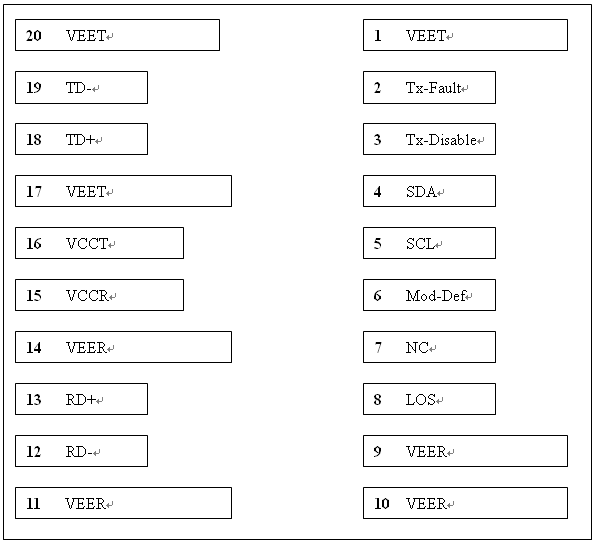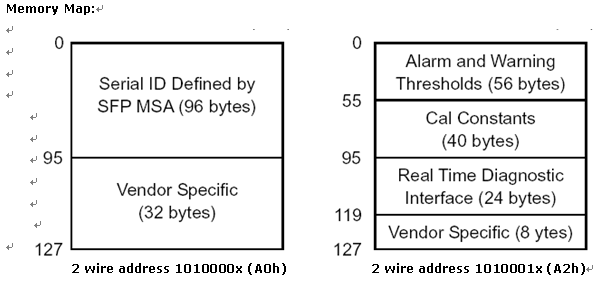Garant Optima Co., Ltd |
|
JM-SB3155-3-10-SDI SFP optical transceiver includes two parts--the JM-SB31-3-10-SDI and JM-SB55-3-10-SDI
Features Description
1,For JM-SB31-3-10-SDI part,
>>1310nm DFB Laser diode transmitter,
>>1550nm InGaAs PIN photodiode receiver,
For JM-SB55-3-10-SDI part,
>>1550nm DFB Laser diode transmitter
>>1310nm InGaAs PIN photodiode receiver
2,SMPTE 424M/297M compliant
3,SMPTE 292M/259M/297M compatiable.
4,Robust error free transmission of signals from 50Mbps to 3Gbps with up to 10km single-mode fiber
5,Maximum distance of 10km under worst-case conditions and 3Gbps video pathological signals
6,Supports video pathological patterns for SD-SDI,HD-SDI and 3G-SDI
7,SFP Package.Hot-pluggable
8,Metal enclosure for lower EMI
9,+3.3V single power supply.
10,Laser disable pin
11,Digital diagnostics and control via I²C interface, including:
12,Monitoring laser bias current, average output power, receive optical power, supply voltage and temperature
13,Alarm reporting when transceiver is at fault
14,Module ID polling
15,Compliant ROHS and lead free
Applications
SMPTE 297-2006 compatible optical-to-electrical interfaces
Descriptions
The JM-SB31-3-10-SDI is a single channel Bi-Directional optical transceiver module designed to transmit and receive optical serial digital signals as defined in SMPTE 297-2006. It is specifically designed for robust performance in the presence of SDI pathological patterns for SMPTE 259M, SMPTE 344M,SMPTE 292M and SMPTE 424M serial rates.
The JM-SB55-3-10-SDI is a single channel Bi-Directional optical transceiver module designed to transmit and receive optical serial digital signals as defined in SMPTE 297-2006. It is specifically designed for robust performance in the presence of SDI pathological patterns for SMPTE 259M, SMPTE 344M,SMPTE 292M and SMPTE 424M serial rates.
Functional Block Diagram

Pin Description
Pin Out Diagram

Pin Function Definition
| Pin# | Name | Description | Notes |
| 1 | VEET | Transmitter Ground | - |
| 2 | TX-Fault | Transmitter Fault Indication | Note 1 |
| 3 | TX-Disable | Transmitter Disable | Note 2, Module disables on high or open |
| 4 | SDA | I²C Data | Note 3 |
| 5 | SCL | I²C Clock | Note 3 |
| 6 | Mod-Def | Module present indicate | Note 3, Grounded in Module |
| 7 | NC | No Connection | - |
| 8 | LOS | Los of signal | Note 4 |
| 9 | VEER | Receiver Ground | - |
| 10 | VEER | Receiver Ground | - |
| 11 | VEER | Receiver Ground | - |
| 12 | RD- | Inv. Received Data Out | Note 5 |
| 13 | RD+ | Receiver Data out | Note 5 |
| 14 | VEER | Receiver Ground | - |
| 15 | VCCR | Receiver Power | Note 6, 3.3V± 5% |
| 16 | VCCT | Transmitter Power | Note 6, 3.3V± 5% |
| 17 | VEET | Transmitter Ground | - |
| 18 | TD+ | Transmit Data In | Note 7 |
| 19 | TD- | Inv. Transmit Data In | Note 7 |
| 20 | VEET | Transmitter Ground | - |
Note:
1. TX-Fault is an open collector/drain output, which should be pulled up with a 4.7K–10KΩ resistor on the host board. Pull up voltage between 2.0V and VCC+0.3V. When high, output indicates a laser fault of some kind. Low indicates normal operation. In the low state, the output will be pulled to < 0.8V.
2. TX-disable is an input that is used to shut down the transmitter optical output. It is pulled up within the module with a 4.7–10 KΩ resistor. Its states are:
Low (0 – 0.8V): Transmitter on
(>0.8, < 2.0V): Undefined
High (2.0 – 3.465V): Transmitter Disabled
Open: Transmitter Disabled
3. These pins should be pulled up with a 4.7K – 10KΩ resistor on the host board. The pull-up voltage shall be VCCT or VCCR. Mod-Def is grounded by the module to indicate that the module is present .
4. LOS (Loss of Signal) is an open collector/drain output, which should be pulled up with a 4.7K – 10KΩ resistor. Pull up voltage between 2.0V and VccT, R+0.3V. When high, this output indicates the received optical power is below the worst-case receiver sensitivity(as defined by the standard in use). Low indicates normal operation. In the low state, the output will be pulled to < 0.8V.
5. RD-/+: These are the differential receiver outputs. They are AC coupled 100Ω differential lines which should be terminated with 100Ω (differential) at the user SERDES. The AC coupling is done inside the module and is thus not required on the host board.
6. VccR and VccT are the receiver and transmitter power supplies. They are defined as 3.3V ±5% at the SFP connector pin. Maximum supply current is 300mA. Recommended host board power supply filtering is shown below. Inductors with DC resistance of less than 1Ω should be used in order to maintain the required voltage at the SFP input pin with3.3V supply voltage. When the recommended supply filtering network is used, hotplugging of the SFP transceiver module will result in an inrush current of no more than 30 mA greater than the steady state value.
7. TD-/+: These are the differential transmitter inputs. They are AC-coupled, differential lines with 100Ω differential termination inside the module. The AC coupling is done inside the module and is thus not required on the host board.
Recommended Host Board Supply Filtering

Optical Connector Requirements
An LC connector with PC/UPC polish is required for each port.
Performance Specifications
Absolute Maximum Ratings
| Parameter | Symbol | Min. | Max. | Unit |
| Storage Temperature | TST | -40 | +85 | ℃ |
| Operating case Temperature | Tcase | -20 | +85 | ℃ |
| Input Voltage | - | GND | VCC | V |
| Power Supply Voltage | VCC-VEE | -0.5 | +3.6 | V |
| Parameter | Symbol | Min. | Max. | Unit |
| Power Supply Voltage | VCC | +3.1 | +3.5 | V |
| Operating Temperature | To | 0 | +70 | ℃ |
Transmitter E-O characteristics
| Parameter | Symbol | Min. | Typ. | Max. | Unit | Note |
| Bit Rate | BR | 50 | - | 3000 | Mbps | - |
| Center Wavelength | l | 1290 | 1310 | 1330 | nm | - |
| Spectral Width (-20dB) | Dl | - | - | 1 | nm | - |
| Side Mode Suppression Ratio | SMSR | 30 | - | - | dB | |
| Average Optical Output Power | Po | -8 | -5 | -2 | dBm | - |
| Extinction Ratio | ER | 5 | - | - | dB | - |
| Power Supply Current | ICC | - | 70 | 180 | mA | - |
| Transmitter Enable Voltage | Ven | 0 | - | 0.8 | - | - |
| Transmitter disable Voltage | VD | 2.0 | - | VCC | V | - |
| Data Inputs Voltage | VPP | 300 | 800 | 1600 | mV | - |
| Optical Rise Time (20%~80%) | Tr | - | 105 | 165 | ps | SMPTE 424M 2.97Gbps |
| - | 170 | 270 | ps | SMPTE 292M 1.485Gbps | ||
| - | 300 | 800 | ps | SMPTE 259M 270Mbps | ||
| Optical Fall Time (80%~20%) | Tf | - | 120 | 180 | ps | SMPTE 424M 2.97Gbps |
| - | 170 | 270 | Ps | SMPTE 292M 1.485Gbps | ||
| - | 300 | 800 | ps | SMPTE 259M 270Mbps | ||
Optical Signal Intrinsic Jitter |
- | - | 45 | 70 | ps | SMPTE 424M 2.97Gbps |
| - | 60 | 100 | ps
| SMPTE 292M 1.485Gbps
| ||
| - | 110 | 180 | ps | SMPTE 259M 270Mbps |
Receiver O-E characteristics
| Parameter | Symbol | Min. | Typ. | Max. | Unit | Note |
| Bit Rate | BR | 50 | - | 3000 | Mbps | - |
| Wavelength | l | 1480 | - | 1580 | nm | - |
| Saturation | Ps | -6 | - | - | dBm | - |
| LOS Asserted | - | -35 | - | - | dBm | - |
| LOS De-Assert | - | - | - | -20 | dBm | - |
| LOS Hysteresis | - | - | 3 | - | dB | - |
| LOS LOW voltage | VLout | - | - | 0.8 | V | - |
| LOS HIGH voltage | VHout | 2.0 | - | - | V | - |
Sensitivity for SMPTE 259M 270Mbps | - | - | -22 | -20 | dBm | Pathological |
| - | -24 | -22 | dBm | PRBS | ||
Sensitivity for SMPTE 292M 1.485Gbps | - | - | -22 | -20 | dBm | Pathological |
| - | -24 | -22 | dBm | PRBS | ||
Sensitivity for SMPTE 424M 2.97Gbps |
- | - | -19 | -18 | dBm | Pathological |
| - | -21 | -20 | dBm | PRBS | ||
| Data Outputs Voltage | Vpp | 400 | 800 | 1000 | mV | - |
| Input Power Monitoring Accuracy | -1 | +1 | dB | - |
Note: The sensitivity specification refers to the input power levels for BER = 1E-12 against PRBS 2^23-1.
EEPROM Section
The optical transceiver contains an EEPROM. It provides access to sophisticated identification information that describes the transceiver’s capabilities, standard interfaces, manufacturer, and other information. The serial interface uses the 2-wire serial CMOS EEPROM protocol defined for the ATMEL AT24C01A/02/04 family of components. When the serial protocol is activated, the host generates the serial clock signal (SCL). The positive edge clocks data into those segments of the EEPROM that are not write protected within the SFP transceiver. The negative edge clocks data from the SFP transceiver. The serial data signal (SDA) is bi-directional for serial data transfer. The host uses SDA in conjunction with SCL to mark the start and end of serial protocol activation. The memories are organized as a series of 8-bit data words that can be addressed individually or sequentially.
The Module provides diagnostic information about the present operating conditions. The transceiver generates this diagnostic data by digitization of internal analog signals. Calibration and alarm/warning threshold data is written during device manufacture. Received power monitoring, transmitted power monitoring, bias current monitoring, supply voltage monitoring and temperature monitoring all are implemented. The diagnostic data are raw A/D values and must be converted to real world units using calibration constants stored in EEPROM locations 56 – 95 at wire serial bus address A2h. The digital diagnostic memory map specific data field define as following.

Recommended Circuit

Note: 4.7K ohms﹤RES﹤10K ohms
Package information

Recommended Board Layout Hole Pattern
